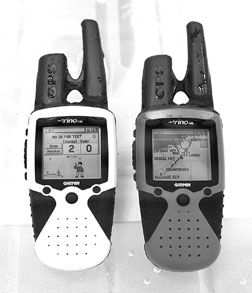Merging more than one function into a single piece of electronics is a big trend now, and Garmin is seizing the day with its RINO series. RINO stands for Radio Integrated with Navigation for the Outdoors. Two models are on the market, the RINO 110 and 120.

Both are handheld GPS receivers with communications capability on FRS (Family Radio Service) and GMRS (General Mobile Radio Service) channels. Garmin has a patent for the “peer-to-peer position reporting” feature built into RINO. It allows position reporting from one RINO unit to another over FRS channels.
Let’s say you have a mother ship and a dinghy, with a RINO aboard each. The position-reporting feature would let each boat operator keep track of the position of the other vessel. This could be a handy feature…if it works well.
The problem is that the position is transmitted on the FRS channels only. With the band’s short range, it limits the feature’s usefulness. Garmin claims that the RINO is capable of transmitting and receiving voice communications at ranges up to two miles on FRS channels and up to five miles on GMRS channels. But we found the radios capable of communicating with each other at a maximum distance of only about a half-mile on FRS channels and roughly three-quarters of a mile on GMRS.
Garmin spokesman Ted Gartner said two things might have affected the radio range. “You may want to go to the Radio Setup page and adjust the Internal Microphone Sensitivity. This may improve range if low modulation was the culprit. Interference from other electronic devices may have also degraded the signal.”
We checked this and found the sensitivity set at maximum. Plus, we did our range testing over open water with one tester in a kayak and the other in a large outboard-powered test boat. Antenna height was about three feet above the water in the kayak and six feet in the powerboat. We don’t think anything interfered with the signal, as each vessel had the other in visual contact at all times. The low antenna heights certainly contributed to the less-than-advertised range, but the range claim is overly optimistic, from what we could tell.
Garmin claims these units are waterproof—able to keep water out for 30 minutes when submerged to a depth of one meter. Neither unit appeared to suffer any ill effect from being submerged for about 15 minutes in a few inches of water. As a final check, we attempted to turn on each unit again the following day. The 120 would not light up, so we pulled the cover off the battery case and found about an ounce of dirty water inside. The batteries were destroyed. Once we dried the interior of the case and installed another set of batteries, the unit functioned normally.
“It is unfortunately very difficult to waterproof a user-accessible portion of a product,” Gartner explained. “Even small debris can easily become lodged in the seal area to create a significant leak path.”
Good Features
Operation of all features and access to various menus is accomplished via seven buttons: the On-Off, Call, Talk, Page, Volume, Zoom, and Cursor/Clicker. In typical Garmin fashion, the controls and menus are easy to operate and intuitive. The RINO 110 has basic navigation and communications features, including a WAAS-enabled GPS receiver, a total of 22 radio channels, 38 special codes that allow the unit to block unwanted communications, storage space for 500 waypoints and 20 routes—and a trip computer with speed, time, and distance tracking, plus sun and fishing tables.
Additional features found in the RINO 120 are a base map of the Americas, a rudimentary voice scrambler, and the ability to store up to 8MB of Garmin-downloadable cartography.
Garmin claims a battery life of 15 hours on 3 AA cells. We didn’t test the life of the batteries, but did use each unit for several hours with no problems.
The RINO fits nicely in your hand. The 110 and 120 weigh 8 ounces and 8.5 ounces, respectively.
We found the RINO 120 at several sites on the Internet for just under $200 each, while the basic 110 was selling for a tad below $150 each. Both carry a one-year warranty.
Bottom Line
We can imagine situations on the water in which a pair of RINOs would be useful—but in those situations we can also imagine needs being met with equipment already in hand—fixed and portable GPS receivers and VHF or FRS radios. While we think the RINO would probably be a boon for hikers (given better radio range than we experienced), it seems to us that for sailors it’s more like the answer to an unasked question. Most boats already carry proven devices that can do the job.
Contact – Garmin, 913/397-8200, www.garmin.com.




































